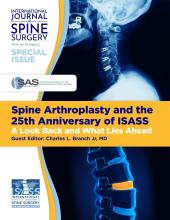ABSTRACT
Background Giant pseudomeningoceles are an uncommon complication of spine surgery. Surgical management and extirpation can be difficult, and guidelines remain unclear.
Methods Here, we present a 56-year-old female patient with a history of grade III L5–S1 spondylolisthesis who was treated with 2 prior spine surgeries. The patient was treated with bone grafting for pseudarthrosis and instrumentation from L4 to ilium. After unsuccessful intraoperative and postoperative cerebrospinal fluid drainage and dural repair, the patient presented to the emergency room with debilitating positional headaches.
Results The patient underwent dural repair with bovine pericardial patch inlay sutured with 7-0 prolene, blood patch, and a dural sealant. Plastic surgery performed a layered closure, using acellular dermal matrix over the dural closure. The bilateral paraspinal flaps were advanced medially to cover the entirety of the acellular dermal matrix, and the fasciocutaneous flaps were then advanced to the midline for a watertight closure. At 3-month follow-up, the patient was headache free and had returned to her activities of daily living.
Conclusions We conclude that early consultation with plastic surgery can be greatly beneficial to effectively extirpate dead space and resolve giant sacral pseudomeningoceles, especially if there is concern of persistent cerebrospinal fluid leakage due to relatively immobile avascular soft tissue as a result of prior revision surgery.
- giant pseudomeningocele
- durotomy
- pseudomeningocele
- management of pseudomeningocele
- revision surgery
- postural headaches
- positional headaches
Footnotes
Disclosures and COI: There were no conflicts of interest or sources of funding for this work.
- This manuscript is generously published free of charge by ISASS, the International Society for the Advancement of Spine Surgery. Copyright © 2020 ISASS.







